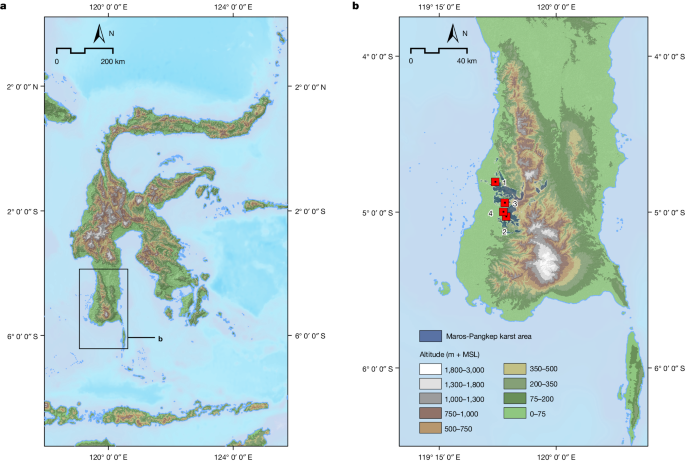Earliest Known Narrative Cave Art Discovered in Indonesia, Dating Back Over 51,200 Years
מושגי ליבה
The discovery of narrative cave art in Indonesia dating back over 51,200 years represents the earliest known example of representational art and visual storytelling in the world.
תקציר
The content describes the findings of a study that used a novel laser-ablation uranium-series imaging technique to re-date some of the earliest cave art in the Maros-Pangkep region of Sulawesi, Indonesia. The key insights are:
A hunting scene from Leang Bulu' Sipong 4 cave, previously dated to a minimum of 43,900 years ago, has now been dated to a minimum of 50,200 years ago, making it over 4,000 years older than previously thought.
A newly described cave art scene at Leang Karampuang cave has been dated to a minimum of 53,500 years ago, making it the earliest known surviving example of representational art and visual storytelling in the world. This narrative composition depicts human-like figures interacting with a pig.
These findings push back the origins of figurative portrayals of anthropomorphic figures and animals, as well as the representation of these in composed scenes, in the history of modern human (Homo sapiens) image-making.
The study demonstrates the power of the new laser-ablation uranium-series imaging technique to provide more accurate minimum ages for ancient cave art, leading to a significant revision of the timeline for the emergence of representational art and visual storytelling.
Narrative cave art in Indonesia by 51,200 years ago - Nature
סטטיסטיקה
The hunting scene from Leang Bulu' Sipong 4 cave has a minimum age of 50.2 ± 2.2 thousand years ago.
The cave art scene at Leang Karampuang has a minimum age of 53.5 ± 2.3 thousand years ago.
ציטוטים
"Painted at least 51,200 years ago, this narrative composition, which depicts human-like figures interacting with a pig, is now the earliest known surviving example of representational art, and visual storytelling, in the world."
"Our findings show that figurative portrayals of anthropomorphic figures and animals have a deeper origin in the history of modern human (Homo sapiens) image-making than recognized to date, as does their representation in composed scenes."
תובנות מפתח מזוקקות מ:
by Adhi Agus Ok... ב- www.nature.com 07-03-2024
https://www.nature.com/articles/s41586-024-07541-7
שאלות מעמיקות
What other types of prehistoric art or artifacts might be discovered in the Maros-Pangkep region that could further expand our understanding of early human cultural development?
The Maros-Pangkep region has already revealed ancient narrative cave art dating back over 50,000 years, indicating a rich cultural history. Further exploration in the area could potentially uncover more diverse forms of prehistoric art, such as hand stencils, geometric patterns, or abstract symbols. Additionally, the discovery of sculptures, pottery, or personal adornments like beads or pendants could provide insights into the artistic and symbolic expressions of early human communities in the region. By studying a wider range of artifacts, researchers may gain a more comprehensive understanding of the cultural practices, beliefs, and social structures of these ancient societies.
How might the discovery of this ancient narrative cave art challenge or refine current theories about the cognitive and creative capabilities of early modern humans?
The discovery of ancient narrative cave art in the Maros-Pangkep region challenges existing theories about the cognitive and creative abilities of early modern humans by pushing back the timeline of representational art. The intricate storytelling depicted in the cave art suggests a sophisticated level of symbolic thinking, narrative construction, and artistic expression among these prehistoric communities. This challenges previous assumptions that such complex cognitive abilities only emerged much later in human history. The discovery indicates that early modern humans possessed advanced cognitive and creative capacities, enabling them to create elaborate visual narratives that reflect their beliefs, experiences, and social interactions. This challenges the traditional linear view of human cognitive evolution and highlights the complexity and richness of early human cultures.
What insights could further research into the materials, techniques, and symbolic meanings of this ancient cave art provide about the social, spiritual, or technological aspects of the lives of these prehistoric human communities?
Further research into the materials, techniques, and symbolic meanings of the ancient cave art in the Maros-Pangkep region could provide valuable insights into various aspects of the lives of prehistoric human communities. By analyzing the pigments used in the artwork, researchers can gain knowledge about the available resources, trade networks, and technological capabilities of these ancient societies. Studying the artistic techniques employed, such as brush strokes, layering, or mixing of colors, can reveal the level of skill and craftsmanship possessed by the artists. Additionally, decoding the symbolic meanings of the motifs and narratives depicted in the cave art can offer clues about the social structures, belief systems, rituals, and daily life practices of these early human communities. By integrating these multidisciplinary approaches, researchers can reconstruct a more holistic picture of the social, spiritual, and technological aspects of prehistoric human societies in the Maros-Pangkep region.
0
